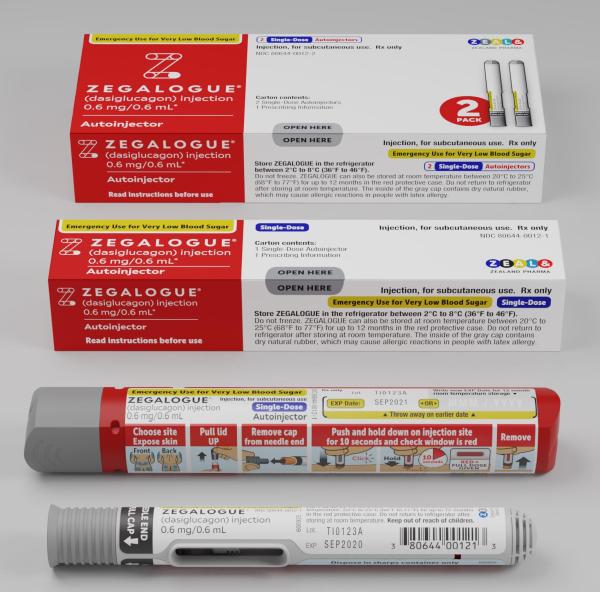Dasiglucagon Dosage
Medically reviewed by Drugs.com. Last updated on Apr 17, 2025.
Applies to the following strengths: 0.6 mg/0.6 mL
Usual Adult Dose for:
Usual Pediatric Dose for:
Additional dosage information:
Usual Adult Dose for Hypoglycemia
0.6 mg subcutaneously once into lower abdomen, buttocks, thigh, or outer upper arm
If there has been no response after 15 minutes, a second 0.6 mg dose may be administered
Comments:
- Patients/caregivers should be familiar with instructions for use; this drug should be administered as soon as possible when severe hypoglycemia is recognized.
- Call for emergency assistance immediately after administering dose.
- Once patient has responded to treatment, oral carbohydrates should be given to restore liver glycogen stores.
Use: For the treatment of severe hypoglycemia in patients with diabetes.
Usual Pediatric Dose for Hypoglycemia
6 years or older: 0.6 mg subcutaneously once into lower abdomen, buttocks, thigh, or outer upper arm
If there has been no response after 15 minutes, a second 0.6 mg dose may be administered
Comments:
- Patients/caregivers should be familiar with instructions for use; this drug should be administered as soon as possible when severe hypoglycemia is recognized.
- Call for emergency assistance immediately after administering dose.
- Once patient has responded to treatment, oral carbohydrates should be given to restore liver glycogen stores.
Use: For the treatment of severe hypoglycemia in pediatric patients 6 years or older with diabetes.
Renal Dose Adjustments
No adjustment recommended
Liver Dose Adjustments
No adjustment recommended
Precautions
CONTRAINDICATIONS:
- Pheochromocytoma
- Insulinoma
Safety and efficacy have not been established in patients younger than 6 years.
Consult WARNINGS section for additional precautions.
Dialysis
Data not available
Other Comments
Administration advice:
- For subcutaneous administration only
- Inject into outer upper arms, lower abdomen, front or back of thighs, or buttocks; roll back clothing to expose bare skin; do not inject through clothes
- The autoinjector and prefilled syringe each contain a single dose; do not reuse
- Review instructions for use with patient/caregivers prior to, and each time medicine is dispensed
Storage requirements:
- Store in refrigerator 36F to 46F (2C to 8C) in red protective case; do not freeze
- May store at room temperature (68F to 77F [20C to 25C]) for up to 12 months; do not return to refrigerator after storing at room temperature
- Upon removal from refrigerator, date label with new expiration date
Reconstitution/preparation techniques:
- Consult instructions for use included in packaging; be familiar with use before an emergency occurs
- AUTOINJECTOR: Pull gray cap off, push and hold straight down on skin until the yellow needle guard is fully pressed down (you may hear a click); keep holding down for 10 seconds and/or until the medicine window turns red (you may hear a second click); remove by lifting straight up; dispose of in a sharps container
- PREFILLED SYRINGE: Remove gray needle cover, pinch skin, and insert entire needle into skin at a 45-degree angle, release skin, and slowly press plunger until plunger rod stops; remove needle carefully; dispose of in a sharps container
General:
- The inside of the gray cap on the prefilled syringe and autoinjector contains a dry natural rubber (a derivative of latex).
- Patients/caregivers should be familiar with administration and management of severe hypoglycemia prior to an emergency; emergency help should be sought after administration as hypoglycemia may occur after treatment.
- This product has a shelf-life of 36 months at refrigerated temperatures and is stable for up to 12 months at room temperature.
Monitoring:
- Blood glucose should be monitored to ensure efficacy; frequent monitoring of blood glucose should occur after a severe hypoglycemic episode.
Patient advice:
- Patients/caregivers should be instructed to read the US FDA-approved patient labeling (Patient Information and Instructions for Use).
- Patients/caregivers should be able to recognize the signs and symptoms of severe hypoglycemia and know the risks of prolonged hypoglycemia.
- Patients/caregivers should understand the risk of allergic reactions and seek immediate medical attention if symptoms of a serious hypersensitivity reaction develop.
More about dasiglucagon
- Check interactions
- Compare alternatives
- Side effects
- During pregnancy
- Drug class: glucose elevating agents
- Breastfeeding
- En español
Patient resources
Other brands
Professional resources
Other brands
Related treatment guides
See also:
Further information
Always consult your healthcare provider to ensure the information displayed on this page applies to your personal circumstances.


